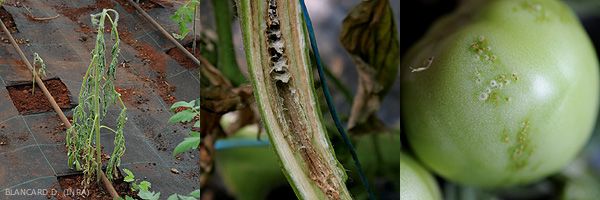
Bacterial diseases
Some 250 species, biovars and pathovars, representing 17 bacterial genera have been identified in bacteria. Six genera can affect tomatoes more or less seriously: Pseudomonas, Ralstonia, Xanthomonas, Clavibacter, Pectobacterium (ex- Erwinia ) and Agrobacterium . The Pseudomonas are divided into two entities: fluorescent ( P. syringae . Pv tomato , P. syringae . Pv syringae ) and non-fluorescent ( P. corrugata ) depending on the training or not, on the middle of King of a pigment which is diffusible and fluorescent under UV light. Among the Pectobacterium , we will mainly mention P. carotovorum subsp. carotovorum which is damaging to the stems and fruits of tomatoes, both during cultivation and during transport and storage.
The bacteria attached to the tomato are relatively autonomous: they can parasitize this plant or live as a saprophyte in its phyllosphere (epiphytic life) and its rhizosphere. Some are found on other plants, in the soil, in organic matter and on many plant debris on which they are easily preserved. Their wall gives them a certain resistance to stress.
All organs of the plant can be affected:
- leaves and fruits ( P. syringae pv. tomato, Xanthomonas spp., Clavibacter michiganensis subsp. michiganensis, P. carotovorum subsp. carotovorum );
- les racines ( Agrobacterium tumefaciens , A. radiobacter ) ;
- the stem pith ( P. carotovorum subsp. carotovorum, P. corrugata );
- the vascular system ( C. michiganensis subsp. michiganensis , R. solanacearum , P. carotovorum subsp. carotovorum in certain cases).
They can present very varied symptoms: spots, wilting, rots, tumors
Their penetration into the various organs of the tomato is carried out in several ways:
- through natural openings such as stomata and hydatodes ( P. syringae pv. tomato, Xanthomonas spp.);
- through various accidental injuries (hail or insect damage ) or caused by cultural operations such as budding, defoliation, harvesting ( C. michiganensis subsp. michiganensis, P. carotovorum subsp. carotovorum ).
Once in the tissues, bacteria first develop between plant cells, which they kill quite quickly thanks to different enzymes (proteases, pectinases, amylases, lipases) in order to feed themselves and neutralize the defense reactions of plants . This is especially the case with Pectobacterium spp., Whose pectinolytic enzymes are responsible for soft rots. Bacteria can also disrupt the metabolism of their host plants by producing or interfering with the production of growth regulators. They sometimes produce toxins inducing the formation of a yellow halo around the alterations. Some of their polysaccharides may play a role in inducing wilt, as is the case with R. solanacearum .
Colonized tissues harbor large amounts of bacteria which can be disseminated in different ways:
- by splashing drops of water due to rain or dripping water;
- through contaminated seeds ( C. michiganensis subsp. michiganensis, P. syringae pv. tomato, Xanthomonas spp );
- by man and his tools (especially C. michiganensis subsp. michiganensis );
- by certain animals and certain insects ( P. carotovorum subsp. carotovorum ).
The water present on the plants or soaking the soil is essential for the proper development of bacteria and their dissemination; as such, it is the first factor conditioning bacterial epidemics.
Temperature has less influence on their development, but there are differences in behavior depending on the species. For example, R. solanacearum and to a lesser extent Xanthomonas spp. rather like high temperatures, while P. syringae pv. tomato thrives best in cool, humid periods. This plays a definite role in their distribution in space and in time during the year.





